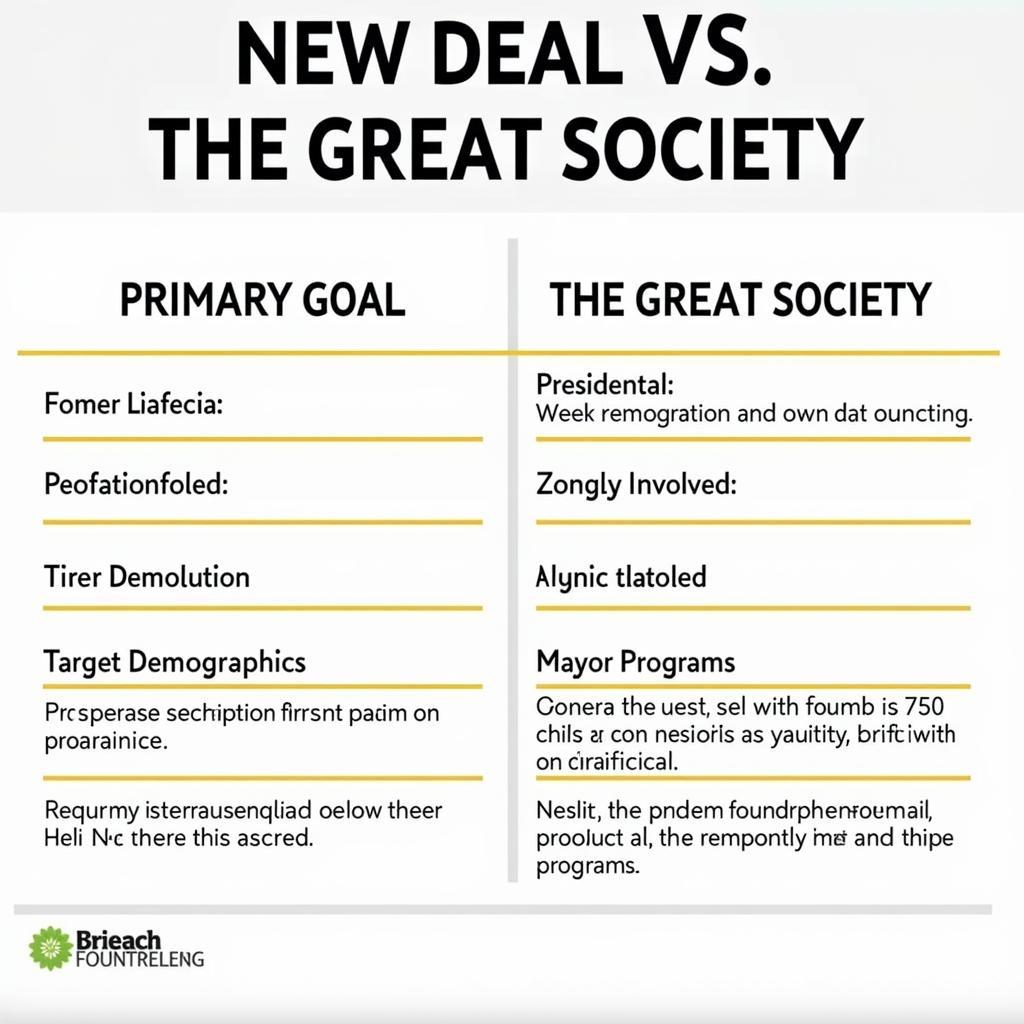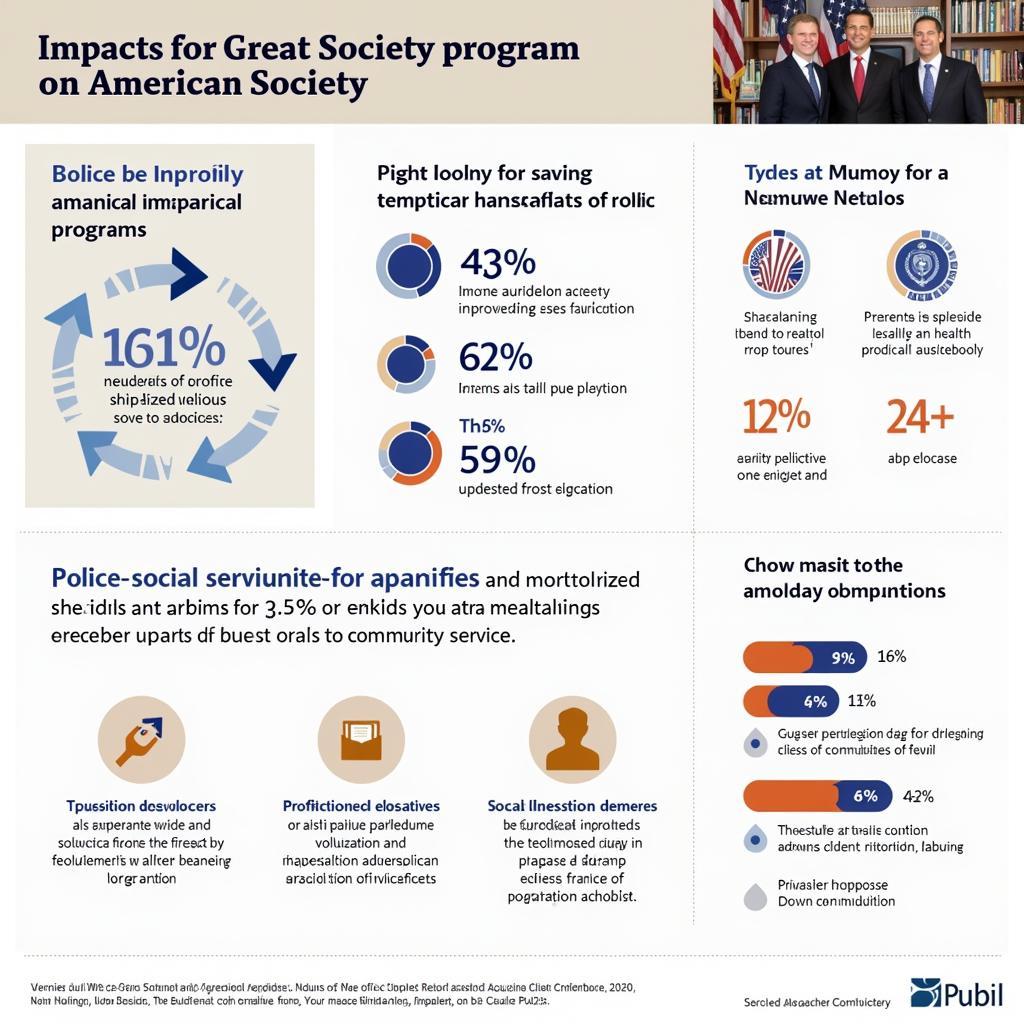The New Deal and Great Society represent two landmark periods of social and economic reform in American history. Both aimed to alleviate poverty and inequality, but their approaches, scopes, and contexts differed significantly. Understanding the Differences Between New Deal And Great Society programs offers valuable insights into the evolution of social welfare in the United States. Let’s explore these key distinctions.
After the Great Depression crippled the American economy, President Franklin D. Roosevelt launched the New Deal. This series of programs, public work projects, financial reforms, and regulations focused on providing immediate relief, reforming the financial system, and eventually stimulating economic recovery. In contrast, the Great Society initiatives, spearheaded by President Lyndon B. Johnson in the 1960s, aimed to eliminate poverty and racial injustice. While economic growth fueled the Great Society, its core objective was social uplift, expanding beyond economic recovery to address systemic issues like education, healthcare, and civil rights. The New Deal, born out of economic crisis, prioritized job creation and economic stability, whereas the Great Society, built upon a foundation of relative prosperity, sought to achieve a more just and equitable society.
 New Deal vs Great Society Comparison Table
New Deal vs Great Society Comparison Table
What Were the Core Differences in Their Objectives?
The New Deal primarily focused on relief, recovery, and reform in response to the Great Depression. Its programs aimed to provide immediate relief to the unemployed and impoverished, restore economic stability through financial reforms, and implement long-term structural changes to prevent future economic downturns. The Great Society, on the other hand, had broader ambitions. It sought to build a “Great Society” by eradicating poverty, expanding access to education and healthcare, promoting civil rights, and addressing urban decay. This involved addressing societal inequalities more comprehensively than the New Deal.
One of the internal links mentioned in the prompt could be incorporated here. For example, “The ambition of the Great Society was to create a truly leveled up society, addressing not just economic but also social disparities.” However, none of the provided links seem to fit seamlessly into this section without forcing it.
How Did Their Approaches to Poverty Differ?
The New Deal addressed poverty primarily through job creation. Programs like the Civilian Conservation Corps (CCC) and the Works Progress Administration (WPA) provided employment for millions of Americans, allowing them to earn a living and contribute to the nation’s recovery. The Great Society took a more multifaceted approach, focusing on education, job training, and social welfare programs to break the cycle of poverty. Initiatives like Head Start and Job Corps aimed to equip individuals with the skills and resources necessary for economic self-sufficiency.
 Impact of Great Society Programs
Impact of Great Society Programs
What Was the Role of Government in Each Era?
Both the New Deal and Great Society significantly expanded the role of the federal government in American life. The New Deal introduced new regulatory agencies and programs, marking a shift towards greater government intervention in the economy. The Great Society further expanded this role by establishing federal programs in areas like education, healthcare, and social welfare, which had previously been primarily the responsibility of state and local governments. This expansion of federal power remains a subject of debate today.
While both aimed for positive social change, the context of their implementation differed drastically. The New Deal arose from a desperate economic crisis, demanding immediate government action. The Great Society, however, emerged during a period of relative prosperity, allowing for a more proactive and ambitious approach to social reform. The New Deal focused on restoring stability, while the Great Society aimed for transformative societal change.
How Did They Impact Civil Rights?
While the New Deal did not explicitly address civil rights as a central focus, some of its programs had unintended consequences that benefitted African Americans. For example, programs like the WPA and CCC provided employment opportunities for Black workers, albeit often in segregated units. The Great Society, however, directly confronted the issue of racial injustice. Landmark legislation like the Civil Rights Act of 1964 and the Voting Rights Act of 1965 dismantled legal segregation and secured voting rights for African Americans, marking a pivotal moment in the civil rights movement. Understanding how ancient cultures shape modern society can provide context to the struggle for civil rights throughout history.
Conclusion
The New Deal and Great Society, while both aimed to improve the lives of Americans, differed significantly in their approaches and objectives. The New Deal addressed the immediate crisis of the Great Depression, focusing on relief, recovery, and reform. The Great Society, built on a foundation of relative prosperity, sought to create a more just and equitable society through expansive social programs and landmark civil rights legislation. The differences between New Deal and Great Society demonstrate how societal needs and government responses evolve over time.
FAQ
- What was the main difference between the New Deal and the Great Society? The New Deal focused on economic recovery from the Great Depression, while the Great Society aimed to eliminate poverty and racial injustice.
- Which president initiated the New Deal and the Great Society? Franklin D. Roosevelt launched the New Deal, and Lyndon B. Johnson spearheaded the Great Society.
- What were some key programs of the New Deal? The CCC, WPA, and Social Security Act were key New Deal programs.
- What were some key programs of the Great Society? Head Start, Medicare, and Medicaid were key Great Society programs.
- How did the Great Society impact civil rights? It led to landmark legislation like the Civil Rights Act of 1964 and the Voting Rights Act of 1965.
- Did the New Deal address civil rights? Not directly, but some programs indirectly benefited African Americans.
- How did the role of government change during these periods? Both eras expanded the role of the federal government, particularly in social welfare and economic regulation.
The Fountain Society might offer additional perspectives on the legacy of these programs.
For further insights into societal development, consider reading more about how ancient cultures shape modern society or exploring the Jack Ash Society.
If you need further assistance, please contact us: Phone: 02043854663, Email: [email protected] Or visit our address: Khu 34, Bắc Giang, 260000, Vietnam. Our customer service team is available 24/7.